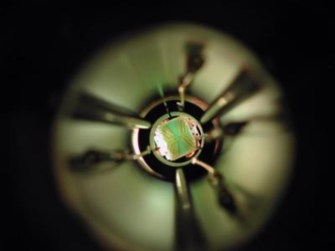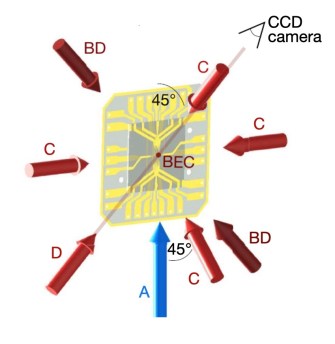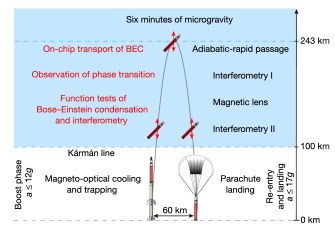
For six minutes, 150 miles above Kiruna, Sweden on January 23, 2017 floated the coldest known spot in the universe. As far as we know, the coldest anything in nature can be is absolute zero on the Kelvin scale, which is –459.67°F and –273.15°C. This postage-stamp-sized atom chip packed tight with thousands of rubidium-87 atoms was just a few billionths of a degree warmer than that. The atom chip was up there in low orbit to help a team of scientist study up-close some of the oddest, least-understood stuff there is: Bose-Einstein condensate (BEC). The team of German scientists was led by Dennis Becker of QUEST-Leibniz Research School, Leibniz University Hannover, Hanover, Germany.
Bose-Einstein condensate is the fifth-known form of matter, after solids, liquids, gases, and plasma. When atoms in zero gravity reach a temperature close to absolute zero, they cede their individuality and act as one “super-atom.” A that point, they’re tens of thousands of atoms all vibrating in sync, creating something like a blob in which the tiniest of disturbances can be detected. Scientists hope that BEC can one day be harnessed for gravitational-wave detection.

The 2010 experiment, close-up.
(Max Planck Institute of Quantum Optics)
THE BEC ON EARTH
In 2010, scientists at the Max Planck Institute of Quantum Optics packed a cylindrical capsule about the size and width of a door with a few million rubidium atoms trapped on an atom chip, lasers, the required energy supply, solenoids, and a camera. They dropped the capsule 146 meters from the top of a tower. It fell for about four seconds, and during the zero gravity of free-fall, they remotely generated a BEC on the atom chip in less than a second. (In the lab, it takes up to a minute.) Once the BEC formed, they released the trap and the camera allowed them to see its spread as it fell. They were able to observe the BEC for a few seconds before it hit bottom.

a. MAUIS launch vehicle; b. The launch compartment; c. The vacuum-sealed device holding the atom chip
(Becker, et al)
THE MID-WINTER 2017 SPACE BEC
The January 23rd experiment was the first time anyone’s created the Bose-Einstein condensate in space. The low gravity allowed them to extend the viewing time too the BEC to six minutes, a massive improvement, allowing researcher to race through 110 remote-controlled experiments. The team’s apparatus was launched into space under the auspices of the MAIUS 1, or Matter-Wave Interferometry in Microgravity.

Image: Becker, et al.
THE ATOMIC CHIP
A magneto-optical trap holding the rubidium atoms formed by laser beams (C) is loaded on an atom chip via a cold-atom beam (A). The BEC is created in, transported by, and released from the magnetic trap of the atom chip. Two additional light beams (BD) induce Bragg diffraction scattering the BEC, and a charge-coupled device (CCD) camera records the BEC using laser light (D).

January’s experiments
(Becker, et al)
HURRY UP AND EXPERIMENT
In one significant experiment, researchers split the BEC with a laser and then were able to watch it rejoin. This could be an important technique because upon parting, the two halves were identical on a quantum level, and any differences observed after rejoicing would indicate some sort of interference, such as a gravitational wave.
NASA has its own Cloud Atom Lab, an ice-chest-sized environment deployed on the ISS for low-gravity BEC research. While Becker’s team made the first space BEC, the NASA team has reportedly been extending the time a BEC can be maintained.
Quantum gas in free fall: Physicists produce a Bose-Einstein condensate at zero gravity
by Max-Planck-Gesellschaft
Experiment with a dramatic fall: The capsule is pulled up to the starting position in the drop tower, where the physicists generate a Bose-Einstein condensate by remote control and observe how it behaves at zero gravity — a step towards extremely-sensitive measuring devices for gravitation. Credit: Image: ZARMS / University of Bremen
(PhysOrg.com) — A sensitive measuring device must not be dropped – because this usually destroys the precision of the instrument. A team of researchers including scientists from the Max Planck Institute of Quantum Optics has done exactly this, however. And the researchers want to use this experience to make the measuring instrument even more sensitive.
The team, headed by physicists from the University of Hanover, dropped a piece of apparatus, in which they generated a weightless Bose-Einstein condensate (BEC), to the bottom of a drop tower at the University of Bremen. The particles in a BEC lose their individuality and can be considered to be a ‘super-particle’. The researchers want to use such an ultra-cold quantum gas at zero gravity to construct a very sensitive measuring device for the Earth’s gravitational field – in order to find deposits of minerals, and also to settle fundamental issues in physics (Science, June 18, 2010).
In a vacuum, a feather falls as quickly as a lead ball – something that is already presented to students as being irrefutable. “However, the equivalence principle is only a postulate that needs to be tested,” says Ernst Maria Rasel, professor at the University of Hanover. According to the equivalence principle, the heavy mass with which bodies attract each other corresponds to the inertial mass, which resists an accelerating force. This means that in a vacuum all bodies hit the ground with the same speed. Physicists want to use a measuring device that measures gravity extremely accurately to investigate whether this hypothesis can really become a physical law. Ernst Maria Rasel’s team has now taken an initial step in this direction.
The researchers generated a Bose-Einstein condensate (BEC) in zero gravity and observed, for more than a second, how the atomic cloud behaves in free fall. To this end, they installed an atom chip developed by researchers working with Theodor W. Hänsch, Director at the Max Planck Institute of Quantum Optics, and solenoids, lasers, a camera and the necessary energy supply into a cylindrical capsule, which is about as high and wide as a door. After they had moved a cloud of several million rubidium atoms onto the atom chip, they dropped the complete apparatus 146 metres into the depths. A tower at the Center of Applied Space Technology and Microgravity of the University of Bremen specializes in such scientific cases.
As the capsule was falling to the ground for four seconds in the drop tower, the researchers generated the BEC on the atom chip, initially by remote control: strong magnetic fields and lasers hold the particles on the chip and cool them. At a few millionths of a degree above absolute zero, the temperature at minus 273.16 degrees Celsius, the particles have lost almost all of their energy and assume a new physical state: all atoms are now in the quantum mechanical ground state so that they can no longer be distinguished as individual particles in the quantum gas.
An atom chip – the fast path to ultra-cold quantum gas
“They behave completely coherently, practically like a heap of atoms that assumes the properties of a single huge atom,” says Tilo Steinmetz, who was involved in the experiment as a researcher from the Max Planck Institute of Quantum Optics. Since the laws of quantum mechanics say that every particle can also be considered to be a wave, it is possible to describe what is happening in a different way: A wave packet of matter forms in which the atoms no longer stay at fixed locations – they are delocalized. This grouping is maintained until an energetic push, however small, mixes it up.
“We generate a BEC in less than a second on our atom chip. With conventional laboratory apparatus, this takes up to one minute,” says Tilo Steinmetz. In addition, an experiment on an atom chip requires significantly less electrical power. “It is thus ideal for use in a drop tower capsule, where energy supply and cooling present a logistical challenge,” says Steinmetz.
As soon as the atoms on the chip had merged into the super-particle, the researchers carefully loosened the hold of the trap and released the BEC. The camera in the capsule now enabled them to observe how the condensate spread. This movement reacts extremely sensitively to external fields – to differences in Earth’s gravitational field, for example. These differences exist because the gravitation at a certain point on Earth depends on the local density of the Earth’s crust. The longer the Bose-Einstein condensate expands, i.e. the longer it floats in zero gravity, the clearer these differences make themselves felt as it expands. With the experiment in the drop tower alone, the researchers extended the time available for a measurement by more than tenfold when compared to a laboratory experiment. This could help in the future to drastically improve the accuracy of measurement data.
Physicists at the Max Planck Institute of Quantum Optics generate the Bose-Einstein condensate on the atom chip quickly and with little electrical power — ideal conditions to repeat the experiment in a capsule in free fall. Credit: Image: Max Planck Institute of Quantum Optics
Ten times more time for a measurement
The differences can be measured in an atom interferometer: A quantum gas, that is the wave-packet of matter, is split into two parts and moves in the gravitational field along different paths through space-time. Gravitation behaves like an optical medium, whose refractive index refracts the waves. As soon as the two parts reunite, there is interference, as is also generated when waves on a water surface run into each other.
“Ultimately, we would like to perform such experiments in space,” says Ernst Maria Rasel. The equivalence principle could also be tested there. To this end, the researchers must drop clouds of different atoms to Earth for as long as possible. They could then find out whether all bodies really fall with the same speed. And the longer the atom clouds remain in zero gravity – that is, the further they fall – the more chance there is of clarifying this.